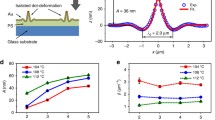Abstract
Three-dimensional (3D) microlens arrays are a group of micro-optics structures on curved surfaces that offer unique optical functions such as wide field of view in a compact arrangement. This paper reports an improved rapid lapping and molding system for 3D fabrication of spherical microlens arrays on non-planar surfaces including concave and convex surfaces for optical applications. Unlike traditional approaches for 3D micro patterns on curved silicon/silica substrates, this research demonstrates a low-cost and efficient chemical mechanical polishing process by lapping precision microlenses with steel balls and diamond slurries. Different from lapping on plane surfaces, lapping parameters for each micro cavity need to be accurately calculated and controlled to obtain microlenses with same apertures. Therefore, a micro wear model for micro cavity lapping process was established to calculate cavity sag height with the knowledge of down force, relative velocity and lapping time. Several groups of microlenses lapping were then conducted under the same conditions to validate the micro wear model. Guided by the micro wear model, two groups of microlens arrays were fabricated on concave and convex surfaces respectively. The shape accuracy and surface texture of the microlens arrays were evaluated by using a white light interferometer. Afterwards, the silica molds were coated with graphene film and then utilized to copy the 3D microstructures onto polymers by rapid surface molding. The wide angle imaging characterization of the 3D polymeric microlens arrays was illustrated by a simple optical setup and the measured MTF curves using the slanted-edge method. The improved manufacturing platform demonstrates a new approach for 3D microlens arrays fabrication on hard substrates in a cost effective way.












Similar content being viewed by others

References
Baker KM (1999) Highly corrected close-packed microlens arrays and moth-eye structuring on curved surfaces. Appl Opt 38(2):352–356
Chen J, Cheng J, Zhang D, Chen S-C (2016) Precision UV imprinting system for parallel fabrication of large-area micro-lens arrays on non-planar surfaces. Precis Eng 44:70–74
Greenwood JA, Williamson JBP (1966) Contact of nominally flat surfaces. Proc R Soc Lond A 295(1442):300–319
Huang W, Jianfeng Yu, Kwak KJ, Gallego-Perez D, Liao W-c, Yang H, Ouyang X, Lei Li W, Lafyatis GP, Lee LJ (2013) Atomic carbide bonding leading to superior graphene networks. Adv Mater 25(33):4668–4672
Li L, Yi AY (2009) Microfabrication on a curved surface using 3D microlens array projection. J Micromech Microeng 19(10):105010
Li H, He P, Jianfeng Yu, Lee LJ, Yi AY (2015) Localized rapid heating process for precision chalcogenide glass molding. Opt Lasers Eng 73:62–68
Liu X, Zhou T, Zhang L, Zhou W, Jianfeng Yu, Lee LJ, Yi AY (2018a) Simulation and measurement of refractive index variation in localized rapid heating molding for polymer optics. J Manuf Sci Eng 140(1):011004
Liu X, Zhou T, Zhang L, Zhou W, Yu J, Lee LJ, Yi AY (2018b) Fabrication of spherical microlens array by combining lapping on silicon wafer and rapid surface molding. J Micromech Microeng 28(7):075008
Luo J, Dornfeld DA (2001) Material removal mechanism in chemical mechanical polishing: theory and modeling. IEEE Trans Semicond Manuf 14(2):112–133
Masaoka K, Yamashita T, Nishida Y, Sugawara M (2014) Modified slanted-edge method and multidirectional modulation transfer function estimation. Opt Express 22(5):6040–6046
Pei ZJ, Fisher GR, Bhagavat M, Kassir S (2005) A grinding-based manufacturing method for silicon wafers: an experimental investigation. Int J Mach Tools Manuf 45(10):1140–1151
Totsu K, Fujishiro K, Tanaka S, Esashi M (2006) Fabrication of three-dimensional microstructure using maskless gray-scale lithography. Sens Actuators A 130:387–392
Waits CM, Modafe A, Ghodssi R (2002) Investigation of gray-scale technology for large area 3D silicon MEMS structures. J Micromech Microeng 13(2):170
Xie P, He P, Yen Y-C, Kwak KJ, Gallego-Perez D, Chang L, Liao W-c, Yi A, Lee LJ (2014) Rapid hot embossing of polymer microstructures using carbide-bonded graphene coating on silicon stampers. Surf Coat Technol 258:174–180
Zhang H, McCray DL, Scheiding S, Naples NJ, Gebhardt A, Risse S, Eberhardt R, Tünnermann A, Yi AY (2013) Development of a low cost high precision three-layer 3D artificial compound eye. Opt Express 21(19):22232–22245
Zhang L, Zhou W, Yi AY (2017) Rapid localized heating of graphene coating on a silicon mold by induction for precision molding of polymer optics. Opt Lett 42(7):1369–1372
Zhao Y, Chang L (2002) A micro-contact and wear model for chemical–mechanical polishing of silicon wafers. Wear 252(3–4):220–226
Zhao Y, Maietta DM, Chang L (2000) An asperity microcontact model incorporating the transition from elastic deformation to fully plastic flow. J Tribol 122(1):86–93
Acknowledgements
This study was partially based on the work supported by National Science Foundation under Grant Number 1537212. Any opinions, findings, and conclusions or recommendations expressed in this material are those of the authors and do not necessarily reflect the views of the National Science Foundation. The authors would also like to acknowledge support of an NSF SBIR Phase I and Phase II program from Nanomaterial Innovation LLC under the Grant Number 1315009 and 1456291. The work was also supported by National Natural Science Foundation of China (No. 51775046). Xiaohua Liu acknowledges the financial support from China Scholarship Council.
Author information
Authors and Affiliations
Corresponding author
Additional information
Publisher's Note
Springer Nature remains neutral with regard to jurisdictional claims in published maps and institutional affiliations.
Rights and permissions
About this article
Cite this article
Liu, X., Zhou, T., Zhang, L. et al. 3D fabrication of spherical microlens arrays on concave and convex silica surfaces. Microsyst Technol 25, 361–370 (2019). https://doi.org/10.1007/s00542-018-3971-6
Received:
Accepted:
Published:
Issue Date:
DOI: https://doi.org/10.1007/s00542-018-3971-6



